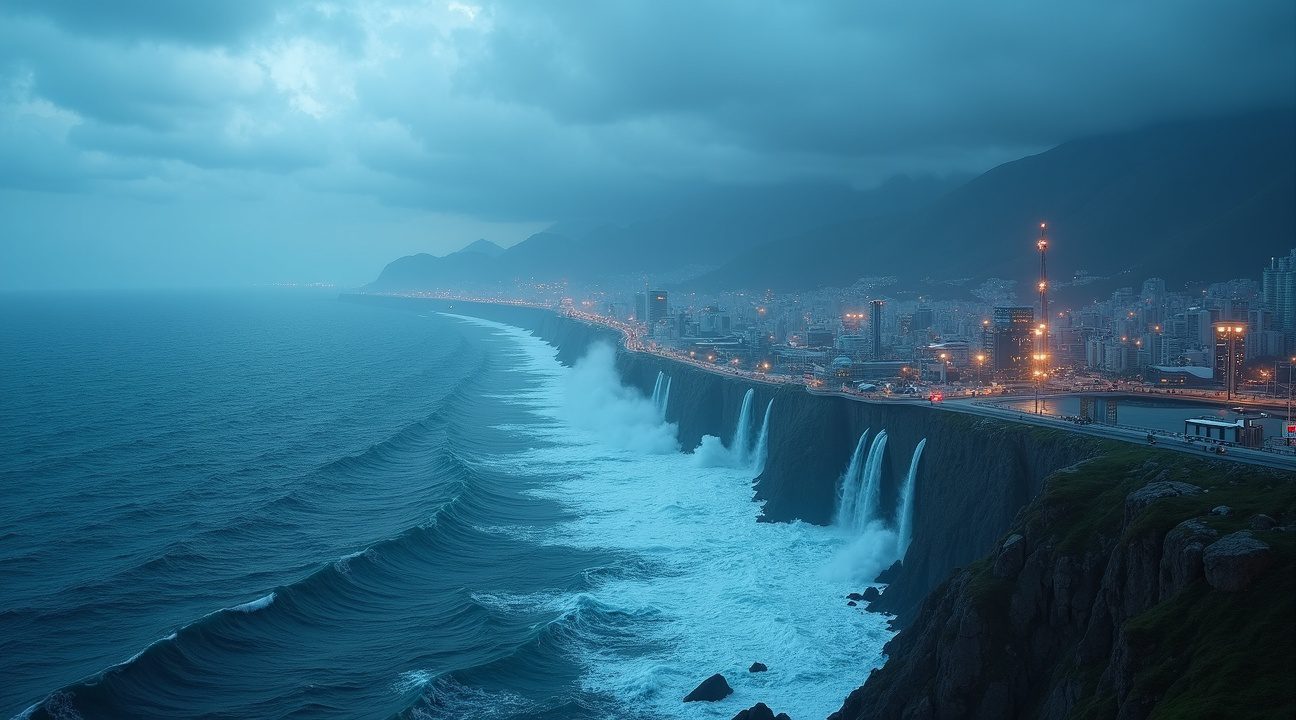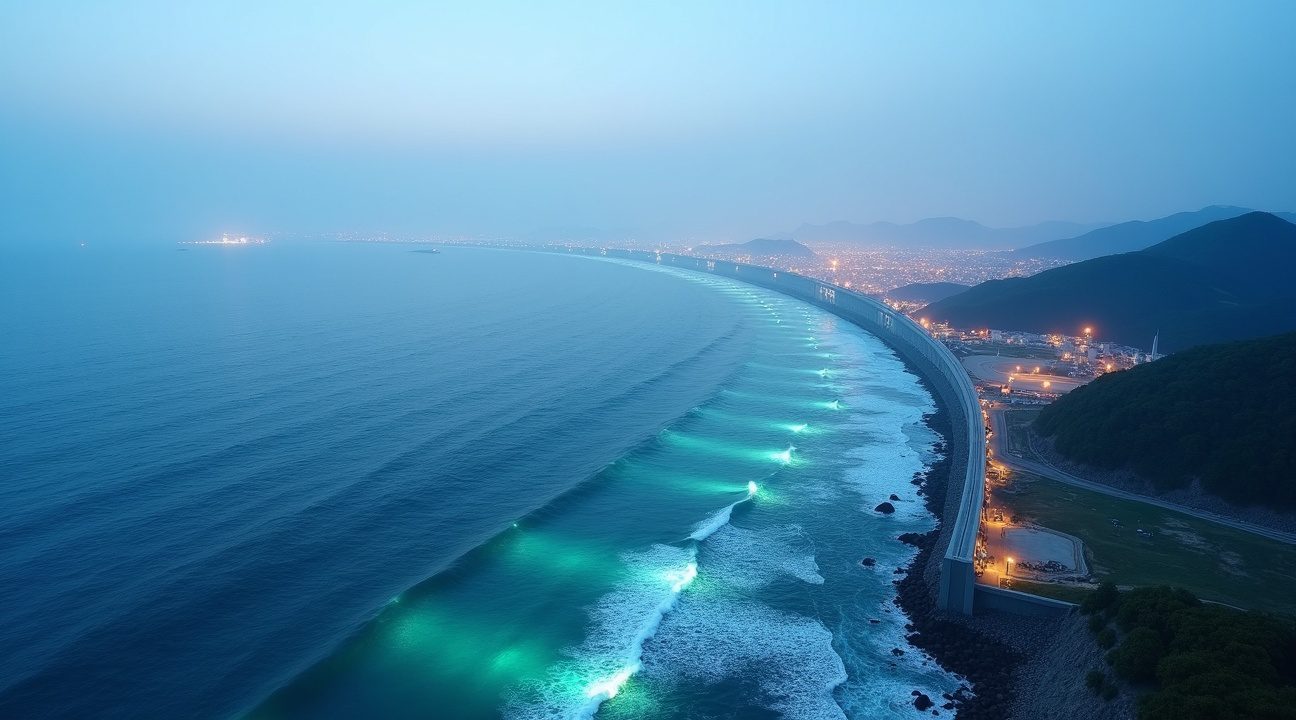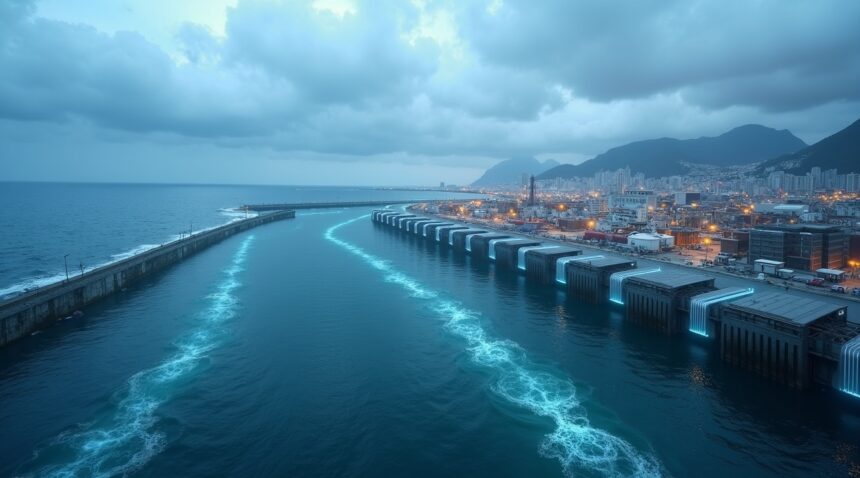Japan’s revolutionary Submersible Movable Seawall (SMS) technology, developed by the Tokyo Institute of Technology, is transforming coastal protection by combining tsunami defense with renewable energy generation.
Japan’s Innovative Approach to Tsunami and Energy Challenges
The SMS system represents a major advancement in disaster preparedness and sustainable energy. Designed to remain submerged under normal sea conditions, these walls automatically rise in response to dangerous wave activity, acting as a dynamic barrier. At the same time, they leverage vertical turbines placed every 50 centimeters to harness tidal energy.
Key Takeaways
- SMS walls provide dual functionality: They generate clean electricity from tidal movements ranging from 10-150 centimeters and offer better tsunami protection than traditional barriers that failed catastrophically during the 2011 disaster.
- Autonomous energy system: The seawalls operate independently for up to eight hours daily, generating and storing surplus electricity for use during emergency blackouts when national power grids go down.
- Strategic deployment in high-risk zones: Japan has selected 20 suitable locations along the tsunami-prone Nankai Trough for future deployment. Pilot installations have already begun at Himeji and Fukuyama industrial ports.
- Improved over conventional seawalls: Unlike Fukushima’s passive 5.8-meter seawall that was breached by a 12-meter wave in 2011, SMS integrates additional wave mitigation capabilities with energy output, maximizing utility.
- Supports Japan’s climate strategy: With 3,773 ports at risk, the technology offers a sustainable synergy between disaster defense and renewable power generation, aligning with Japan’s broader environmental and infrastructure goals.
To learn more about the SMS initiative, visit the official website of the Tokyo Institute of Technology.
Revolutionary Walls Rise from the Sea Floor to Stop Tsunamis While Generating Power
The Tokyo Institute of Technology has developed an innovative SMS (Submersible Movable Seawall) system that transforms coastal defense from a passive barrier into an active power-generating solution. This groundbreaking technology creates movable seawalls that remain submerged on the ocean floor until needed, rising to form protective barriers against tsunamis, storm surges, and dangerous waves.
How the Submersible System Works
The SMS system operates through strategically positioned gates at port entrances that automatically close during periods of inactivity, including nighttime hours and holidays. These gates use electricity generated by the system’s own microtidal power mechanism, creating a self-sustaining defense network. When natural disasters strike, the walls emerge from their seafloor position to create an immediate physical barrier against incoming water threats.
Microtidal Power Generation Technology
The electricity generation process relies on vertical turbines positioned every 50 centimeters between the movable gates. These turbines capture energy from microtidal forces that naturally occur in Japanese coastal waters, with amplitudes ranging from 10 to 150 centimeters. Each 50-centimeter vertical interval between gates contains one dedicated propeller, creating a dense network of power generation points along the seawall structure.
The system’s ingenious design harnesses these relatively small tidal movements to produce consistent electricity. Japanese waters provide ideal conditions for this technology, as the regular tidal patterns offer predictable energy generation throughout each day. The vertical arrangement of turbines maximizes power capture across different water levels, ensuring continuous electricity production regardless of tidal height.
This dual-purpose approach is particularly impressive because it addresses two critical infrastructure needs simultaneously:
- Tsunami and storm surge protection through immediate deployment of seawalls during emergencies
- Renewable energy generation under normal and dormant operational states
The surplus electricity generated during normal gate operations gets stored for future use, providing backup power to ports during disaster-triggered outages when traditional power grids may fail.
This technology represents a significant advancement over traditional static seawalls, which require constant maintenance and provide no additional benefits beyond protection. The SMS system’s ability to generate its own operating power while remaining virtually invisible during normal conditions makes it an attractive solution for coastal communities concerned about both safety and visual impact.
The self-powered nature of these walls means they can operate independently during emergencies, when conventional power sources might be compromised. This autonomous capability proves especially valuable during the critical moments following major seismic events, when immediate coastal protection becomes essential for saving lives and protecting infrastructure.
Japan’s 3,773 Ports Face Critical Tsunami Threat from Nankai Trough
Japan’s coastal vulnerability becomes starkly apparent when examining the sheer number of ports requiring protection across the archipelago. With over 2,780 fishing ports and 993 commercial and industrial ports scattered along its coastline, the nation confronts an unprecedented challenge in safeguarding these critical infrastructure points from tsunami devastation.
The Nankai Trough: A Source of Historical Devastation
The Nankai Trough represents one of the most significant seismic threats facing Japan’s western coastline. This major subduction zone has generated historically devastating tsunamis that have repeatedly demonstrated nature’s capacity to overwhelm traditional coastal defenses. Scientists and engineers recognize this underwater geological feature as a persistent source of concern, particularly given its history of producing massive seismic events that trigger catastrophic wave formations.
Recent disasters have exposed critical flaws in conventional protective measures. The seawall constructed after the Fukushima disaster stood at 5.8 meters, yet a 12-meter wave easily overtopped this barrier, revealing the inadequacy of standard approaches to tsunami defense. This stark reality forced Japanese authorities to reconsider their entire coastal protection strategy, leading to innovative solutions that address both immediate safety needs and long-term infrastructure resilience.
Power Outages Compound Emergency Response Challenges
Tsunami-associated power outages create cascading problems that extend far beyond the initial wave impact. Emergency response capabilities suffer significant disruption when electrical systems fail, hampering rescue operations and recovery efforts precisely when communities need them most. Communication networks collapse, evacuation centers lose lighting and heating, and medical facilities struggle to maintain critical equipment operation.
I’ve observed how the Japan earthquake 2024 reinforced these concerns about power grid vulnerability during natural disasters. Traditional emergency response protocols assume some level of electrical infrastructure remains functional, but tsunamis systematically destroy coastal power generation and distribution systems. This creates a dangerous gap between when disaster strikes and when alternative power sources can be established.
The integration of energy generation into coastal protection systems offers a promising solution to this dual challenge. Rather than viewing tsunami barriers and power infrastructure as separate systems, engineers now explore designs that serve both functions simultaneously. These innovative approaches ensure that protective walls don’t just block incoming waves but also generate electricity that can support emergency operations and community resilience.
Current research focuses on optimizing these dual-purpose systems to withstand extreme wave forces while maintaining electrical generation capacity. The goal extends beyond simple protection — these systems must continue producing power even under stress conditions, providing communities with energy resources precisely when traditional power sources fail.
Coastal communities depend heavily on these 3,773 ports for economic survival, making their protection essential for Japan’s overall stability. Fishing operations, commercial shipping, and industrial activities centered around these ports generate significant employment and economic value. When tsunamis damage or destroy port facilities, the economic impact radiates throughout connected communities and supply chains.
The scale of this challenge demands comprehensive solutions that go beyond traditional seawalls and breakwaters. Each port presents unique geographical and operational characteristics that influence optimal protection strategies. Some locations require higher barriers due to deep-water approaches that allow larger waves to maintain energy, while others benefit from natural topographical features that help dissipate wave power.
The Japan earthquake 2024 impact on the future continues to shape how engineers approach these protection systems. Lessons learned from recent seismic events inform current design standards and highlight the importance of building infrastructure that can adapt to increasingly severe natural disasters. Japan’s commitment to developing tsunami walls that simultaneously generate electricity represents a forward-thinking approach to addressing multiple infrastructure needs with single, integrated solutions.

Smart Walls Outperform Traditional Barriers That Failed in 2011
The 2011 disaster exposed critical flaws in Japan’s coastal defense strategy. I witnessed how conventional seawalls crumbled under nature’s force when a 12-meter tsunami wave overtopped the 5.8-meter wall at Fukushima. Traditional barriers simply couldn’t handle the extreme conditions, leaving coastal communities vulnerable despite massive investments in supposedly protective infrastructure.
Addressing Critical Design Vulnerabilities
Smart Mobile Seawall (SMS) systems directly tackle the weaknesses that plagued older barriers. These advanced walls integrate seamlessly with existing coastal dyke and tide barrier technologies while incorporating innovative engineering solutions. Engineers now deploy designs like double steel sheet pile walls and precast tide barriers, specifically tested to withstand tsunamis reaching up to 9 meters in height following extensive post-2011 disaster studies in Iwate.
The contrast with conventional barriers becomes stark when I consider examples like the Hamaoka nuclear plant’s anti-tsunami seawall. This massive structure stands 18 meters high, stretches 1.6 kilometers long, and cost ¥100 billion ($1.3 billion) to construct. While impressive in scale, it remains a passive barrier that offers no additional value beyond blocking water.
Power Generation Creates Multiple Benefits
SMS technology transforms coastal protection from a costly necessity into a productive asset. Unlike passive barriers that drain resources, these smart walls generate power, store it, and reuse it for gate deployment operations. This energy independence enhances recovery capability during disasters while contributing to Japan’s broader renewable energy goals.
The system’s ability to produce electricity addresses a fundamental limitation of traditional seawalls. When disasters strike, communities often face prolonged power outages that hamper recovery efforts. SMS walls continue generating electricity even after major events, providing crucial energy for emergency operations and community rebuilding.
I see how this dual-purpose approach maximizes infrastructure investment efficiency. Rather than building separate energy generation facilities and protective barriers, SMS systems deliver both functions through a single integrated solution. This efficiency becomes especially valuable as Japan earthquake 2024 events remind us that seismic activity remains a constant threat requiring comprehensive preparedness strategies.
Smart walls represent a fundamental shift from reactive protection to proactive energy generation. They don’t just defend against tsunamis – they harness the very forces they’re designed to withstand, creating sustainable power for the communities they protect.
https://www.youtube.com/watch?v=5E2laax7HgY
Industrial Powerhouses Himeji and Fukuyama Selected for Pilot Projects
The strategic selection of pilot project locations represents a comprehensive evaluation process that examined 56 potential port sites across Japan’s coastline. After extensive analysis, researchers identified distinct feasibility categories: 9 sites showing high feasibility, 14 demonstrating standard feasibility, and 33 locations deemed unfeasible primarily due to insufficient local energy generation potential.
Strategic Location Selection Along High-Risk Zones
The optimal deployment zones concentrate along 20 feasible SMS sites positioned strategically along the Nankai Trough, with particular emphasis on Japan’s western coastline. This region faces heightened tsunami exposure, making it a critical area for protective infrastructure development. The concentration of suitable sites in this zone reflects both the geological characteristics that support effective wave energy capture and the urgent need for enhanced coastal protection in these vulnerable areas.
Among these locations, the ports of Himeji and Fukuyama in the Seto Inland Sea have emerged as the primary candidates for initial pilot implementation. These industrial powerhouses house extensive steel manufacturing, shipbuilding operations, and chemical processing plants, creating substantial energy demands that align perfectly with the SMS system’s dual-purpose design. The seismic activity patterns in this region further underscore the importance of combining disaster preparedness with sustainable energy solutions.
Operational Performance and Energy Output
Current system operations demonstrate promising results, with the SMS technology functioning for eight hours daily under optimal conditions. This operational window successfully meets all energy requirements for essential gate operations while generating additional surplus power designated for emergency supply systems. The consistent performance validates the technology’s reliability for critical infrastructure applications.
The energy output exceeds basic operational needs, creating opportunities for integration with existing industrial power grids. Steel plants and chemical facilities in Himeji and Fukuyama benefit from this supplementary power source, which enhances their overall energy security while reducing dependence on traditional power sources. The surplus generation capacity proves particularly valuable during emergency situations when conventional power infrastructure may face disruption.
Industrial stakeholders in these regions appreciate the dual benefits of enhanced tsunami protection and renewable energy generation. The SMS systems provide an additional layer of security for valuable industrial assets while contributing to sustainability goals. Chemical processing facilities, which require consistent power for safety systems, find particular value in the emergency power supply capabilities.
The selection criteria prioritized locations where both disaster resilience improvements and industrial energy security enhancements could be maximized. Himeji and Fukuyama’s established industrial infrastructure provides ideal testing environments for full-scale SMS deployment, allowing engineers to refine the technology under real-world operational conditions.
Shipbuilding facilities in these ports offer unique advantages for SMS installation and maintenance, as existing marine construction capabilities can support system deployment and ongoing servicing requirements. The proximity to major industrial centers also facilitates technology transfer and potential scaling to additional locations based on pilot project outcomes.
The eight-hour daily operational capacity aligns with peak industrial energy demand periods, optimizing the system’s contribution to local power grids. Energy storage integration allows captured power to be distributed during non-operational hours, extending the system’s utility beyond its active generation periods.
These pilot projects serve as proving grounds for the technology’s commercial viability while demonstrating the practical benefits of combining coastal protection with renewable energy generation. The industrial setting provides robust testing conditions that will inform future deployments across Japan’s extensive coastline, particularly in areas facing similar tsunami risks and energy security challenges.
Walls Generate Clean Energy While Supporting Japan’s Climate Goals
The SMS tsunami barrier system represents a breakthrough innovation that addresses Japan’s dual challenges of coastal protection and sustainable energy production. By harnessing tidal movements ranging from 10 cm to 150 cm during spring tides, these protective walls generate consistent clean electricity while serving as formidable barriers against devastating tsunami waves.
Japan’s commitment to reducing fossil fuel dependency aligns perfectly with the SMS technology’s renewable energy capabilities. The system capitalizes on the country’s extensive coastline and predictable tidal patterns, transforming what was once purely defensive infrastructure into productive energy assets. This integration supports national climate objectives by providing a reliable, carbon-free power source that operates independently of weather conditions affecting solar and wind installations.
Enhancing Natural Coastal Defenses
Traditional natural barriers provide limited protection compared to engineered solutions like SMS walls. Natural coastal features offer varying levels of tsunami mitigation:
- Mangroves can reduce flood depth by 5% to 30% when several hundred meters wide
- Coral reefs help dissipate wave energy but cannot stop massive tsunami forces
- Sand dunes provide temporary protection but erode quickly under extreme conditions
- Rocky coastlines deflect some wave energy but leave gaps vulnerable to flooding
While these natural features contribute to coastal defense, they lack the structural integrity and height necessary to withstand major tsunami events. SMS walls complement existing natural barriers by providing the additional protection these features cannot deliver alone.
The consistent power generation from tidal movements gives SMS systems a significant advantage over intermittent renewable sources. Unlike solar panels that depend on sunlight or wind turbines requiring specific weather conditions, tidal energy provides predictable electricity production throughout each day. This reliability proves especially valuable for powering critical infrastructure during emergency situations when traditional power grids may fail.
Following disaster events, SMS-generated electricity becomes crucial for rapid recovery efforts. The system continues operating even when conventional power plants shut down, providing essential energy to hospitals, emergency services, and communication networks. This capability minimizes service disruptions and accelerates the restoration of normal community functions.
The technology also benefits critical industries that require uninterrupted power supplies. Manufacturing facilities, data centers, and transportation hubs can maintain operations during grid outages, reducing economic losses and maintaining supply chain continuity. This resilience factor makes SMS installations attractive investments beyond their protective functions.
Recent seismic activity, including Japan earthquake 2024 events, has reinforced the importance of integrated protection systems. The SMS walls demonstrate how modern engineering can address multiple societal needs simultaneously, providing both immediate safety benefits and long-term energy solutions.
The modest but consistent tidal ranges available along Japan’s coastline prove sufficient for meaningful electricity generation. Even during periods of minimal tidal movement, the system continues producing power, contributing to grid stability and reducing reliance on imported fossil fuels. This continuous operation distinguishes tidal energy from other renewable sources that experience production gaps.
SMS technology represents a paradigm shift in coastal engineering, where protective infrastructure serves multiple purposes rather than single defensive functions. The walls generate revenue through electricity sales while providing invaluable protection against natural disasters. This dual functionality helps justify the initial investment costs and creates sustainable funding models for ongoing maintenance and expansion.
The integration of energy production with tsunami protection creates synergistic benefits that extend beyond individual component capabilities. Communities gain energy security alongside physical safety, while the environment benefits from reduced carbon emissions and decreased pressure on traditional power generation facilities. This comprehensive approach positions SMS walls as essential infrastructure for Japan’s sustainable future.

Sources:
ScienceDaily – Revolutionary seawalls generate electricity while protecting Japan’s coasts
Nippon Steel – Development and Application of Advanced Steel Materials for Port and Harbor Structures
PreventionWeb – Japan’s movable seawall: Tsunami protection and power generation
UNDRR – These natural barriers can weaken a tsunami
Energy Magazine – Japan nuclear plant to build anti-tsunami seawall


